Listen to the Podcast
17 Nov 2023 - Podcast #858 - (18:49)
It's Like NPR on the Web
If you find the information TechByter Worldwide provides useful or interesting, please consider a contribution.

If you find the information TechByter Worldwide provides useful or interesting, please consider a contribution.
The growth of video streaming services and on-demand video has diminished our dependence on over-the-air television, cable television, and video discs. Diminished, that is, not eliminated.
Those who watch local television news or network broadcast programs still depend on the older technology. And sometimes the only way to view a classic film involves buying a DVD or Blu-ray disc, or borrowing it from the library. That was the case for me when I wanted to watch The Maltese Falcon. I’d seen it before, but wanted to view it again because I had just read the book.
While I read The Maltese Falcon, Humphrey Bogart’s voice was in my head. That’s probably understandable. The motion picture was made in 1941, but I didn’t know there was a 1931 motion picture of the same name with Ricardo Cortez as Sam Spade and Bebe Daniels as Ruth Wonderly (Brigid O’Shaughnessy), the part played in 1941 by Mary Astor.
Dashiell Hammett wrote the book in 1929 and things were quite different then. No GPS for one thing. “At a drug-store in Burlingame the chauffeur learned how to reach Ancho Avenue.” The motion picture, as I remembered it, seemed to follow the book closely. That’s unusual today. Sometimes only the names of the characters remain when a book is rewritten as a motion picture script.
When I retrieved the Blu-ray disc from the library, I had two primary choices: Watch on the television or watch on the computer. I decided to use the computer, and then I had one other decision to make: Windows DVD Player, PowerDVD, or VLC Media Player. Neither the Windows Media Player app or the legacy Windows Media Player can play video discs. You have to buy the Windows DVD Player.
Click any small image for a full-size view. To dismiss the larger image, press ESC or tap outside the image.

The Windows DVD Player is a no-frills application while PowerDVD is a full-frills application. The VLC application is in the middle and it’s usually what I use. PowerDVD can play any video source up to HDR 10 and it can cast video to network connected devices around your home such as Roku, FireTV, and Apple TV. Video can also be cast to Android and IOS players. It really is a remarkable program, but it’s priced at $100, or maybe $70 if you catch one of the company’s sales on the PowerDVD site. The discounts are easy to catch because a new one begins when the old one expires.
CyberLink also offers PowerDVD 365 for $60 per year. The primary difference with the rental plan is that includes 100GB of online storage while the single-pay, perpetual license version’s 100GB of online storage terminates after one year. PowerDVD also works only on Windows computers.
Although I purchased PowerDVD several years ago, I decided to use the VLC Media Player. It’s free and it runs on Windows, Apple, and Linux computers. It’s one of the oldest video viewing applications. In 1996, VideoLan was an academic project and VLC was an initialism for "VideoLAN Client". The project intended to stream videos from satellite dishes across a campus network at the École Centrale Paris. Two years later, everything was rewritten and in 2001 the viewer was released under GNU General Public License. The server function is no longer supported.
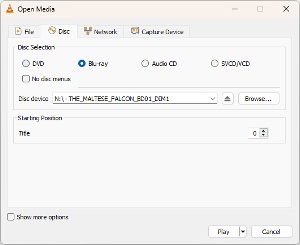 Although VLC doesn’t yet support formats such as HDR 10, it does support all common disc types and video formats up to 8K, audio files, and streaming. For a free application that doesn’t even have a paid version, VLC is remarkable. As with many open-source applications, donations are encouraged, but all the application’s functions work even if you can’t or won’t contribute.
Although VLC doesn’t yet support formats such as HDR 10, it does support all common disc types and video formats up to 8K, audio files, and streaming. For a free application that doesn’t even have a paid version, VLC is remarkable. As with many open-source applications, donations are encouraged, but all the application’s functions work even if you can’t or won’t contribute.
VLC also supports Chromecast, so you can stream video and audio files from your PC or laptop direct to a Chromecast device that’s connected to a TV or a speaker. A full list of the new features is on the VLC website.
VLC version 3 can play 360-degree videos, a feature that’s becoming more important as people buy video cameras that are capable of capturing wrap-around video. Hardware decoding makes it possible for VLC to provide excellent support for these high-resolution files. But did it work with the new Maltese Falcon Blu-ray disc? It did not.
 There is one good reason to consider Power DVD instead of VLC: If you want to watch some of the latest encrypted Blu-ray discs, VLC may not be able to play them. To play any Blu-ray disc, you’ll probably need to download and install two files. I found out about that when I tried to play the new high-definition version of The Maltese Falcon and got only an error message: “This Blu-ray Disc needs a library for AACS decoding, and your system does not have it.”
There is one good reason to consider Power DVD instead of VLC: If you want to watch some of the latest encrypted Blu-ray discs, VLC may not be able to play them. To play any Blu-ray disc, you’ll probably need to download and install two files. I found out about that when I tried to play the new high-definition version of The Maltese Falcon and got only an error message: “This Blu-ray Disc needs a library for AACS decoding, and your system does not have it.”
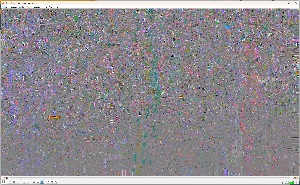 The best VLC could do, even after I worked through the process to enable Blu-ray discs was a mess. The problem affects only some discs, though, mainly ones that have been released recently.
The best VLC could do, even after I worked through the process to enable Blu-ray discs was a mess. The problem affects only some discs, though, mainly ones that have been released recently.
 You’ll need the latest KeyDB.cfg file [keydb.cfg - Language English (20044 entries)], which you can download from here. Unzip the file, then open the Windows file explorer, type %appdata% in the address line, and press Enter. This will open C:\Users\YourUserName\AppData\Roaming\ on your computer where YourUserName is your user name. Create a new directory called aacs in that directory and place the KeyDB.cfg file there.
You’ll need the latest KeyDB.cfg file [keydb.cfg - Language English (20044 entries)], which you can download from here. Unzip the file, then open the Windows file explorer, type %appdata% in the address line, and press Enter. This will open C:\Users\YourUserName\AppData\Roaming\ on your computer where YourUserName is your user name. Create a new directory called aacs in that directory and place the KeyDB.cfg file there.
Next, download the AACS Dynamic Link Library (libaacs.dll) from this site. Be sure to obtain the correct version, 32-bit or 64-bit. You can tell which you have by checking the location.
 After downloading the file, copy it to the VLC program directory and restart VLC. The player will now be able to load most Blu-ray discs, but may still not be able to play it because the KeyDB.cfg file hasn’t been updated since 2017. If your Blu-ray disc isn’t listed, you will hear only the sound track or the video playback will be scrambled.
After downloading the file, copy it to the VLC program directory and restart VLC. The player will now be able to load most Blu-ray discs, but may still not be able to play it because the KeyDB.cfg file hasn’t been updated since 2017. If your Blu-ray disc isn’t listed, you will hear only the sound track or the video playback will be scrambled.
If the Blu-ray disc still doesn’t work, you'll need to use a DVD instead.
This isn’t a problem with PowerDVD, which seems to be capable of playing all current discs. VLC can handle many Blu-ray discs and virtually all DVDs.
Beeper is billed as a universal chat application, but it’s a worthwhile addition to your phone, tablet, or computer even if you use only one chat application.
Click any small image for a full-size view. To dismiss the larger image, press ESC or tap outside the image.
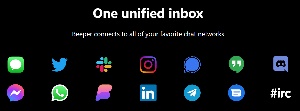 It’s not yet far enough along that you’ll want to uninstall Facebook’s Messenger app, Google Chat, or Discord, but it is sufficiently developed that it can be used instead of the other applications most of the time. Beeper is compatible with Android SMS, Discord, Facebook Messenger, Google Chat, IMessage, IRC, Instagram, LinkedIn, Matrix, Signal, Slack, Telegram, Twitter, and Whatsapp in addition to its own Beeper chat app.
It’s not yet far enough along that you’ll want to uninstall Facebook’s Messenger app, Google Chat, or Discord, but it is sufficiently developed that it can be used instead of the other applications most of the time. Beeper is compatible with Android SMS, Discord, Facebook Messenger, Google Chat, IMessage, IRC, Instagram, LinkedIn, Matrix, Signal, Slack, Telegram, Twitter, and Whatsapp in addition to its own Beeper chat app.
I wrote about Beeper earlier this year, an initial look in June and a follow-up in July. Beeper issues frequent updates to the application and notifies users each time they’ve improved something.
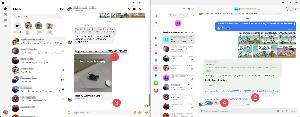 You will want to retain any existing chat apps until Beeper fixes some small problems. Facebook Messenger can display (1) previews for videos, but (2) Beeper can’t. On the other hand, the (3) Facebook Messenger response icons are tiny and (4) Beeper has a much better display. Versions are available for Mac OS, Windows, and Linux computers as well as IPhone, IPad, Android, and Chrome OS mobile devices.
You will want to retain any existing chat apps until Beeper fixes some small problems. Facebook Messenger can display (1) previews for videos, but (2) Beeper can’t. On the other hand, the (3) Facebook Messenger response icons are tiny and (4) Beeper has a much better display. Versions are available for Mac OS, Windows, and Linux computers as well as IPhone, IPad, Android, and Chrome OS mobile devices.
One clever feature Beeper offers is called Notes to Self. A chat in the Beeper channel can be used to record information that only you will see. The information is encrypted and will show up on any device where you have installed Beeper. I frequently see something that I want to follow up when not near the computer, so I can use the phone or tablet to send myself a short note or a URL. This is a much better solution than jotting a note to myself on a piece of paper, better than grabbing the phone and recording a voice memo, and far better than trying to remember it.
A single inbox shows all messages from all chat applications, but each app also has its own separate space within Beeper and Beeper adds encryption even to those apps that don’t support encryption. Beeper’s developers say privacy is a fundamental human right so all Beeper chat messages are end-to-end encrypted. Messages sent using Beeper to other chat networks are re-encrypted if the other network supports encryption. For example: Signal, WhatsApp, and IMessage already encrypt message on their networks.
 For networks that already encrypt messages, Beeper’s web service acts as a relay. If you send a message from Beeper to a friend on WhatsApp, the message is encrypted on the Beeper client and sent to the Beeper web service where the message is converted back to plain text and then re-encrypted using WhatsApp’s proprietary encryption protocol.
For networks that already encrypt messages, Beeper’s web service acts as a relay. If you send a message from Beeper to a friend on WhatsApp, the message is encrypted on the Beeper client and sent to the Beeper web service where the message is converted back to plain text and then re-encrypted using WhatsApp’s proprietary encryption protocol.
The developers say “We would prefer if these chat networks offered open APIs with full end-to-end-encryption, but unfortunately these networks do not support interoperability.... New European legislation is coming into effect in 2024 and will force IMessage and WhatsApp to expose an interoperable end-to-end-encrypted API. Our servers are located in Europe, and we will switch to this open interface as soon as it is ready.”
Beeper collects device information, including operating system, hardware, public IP addresses, network routing information, information on the installed Beeper client, and other device settings as part of its normal operations and uses user account information, such as email addresses and phone numbers, to authenticate users to their accounts. Nothing more.
Beeper also promises to protect the privacy and security of the data users send and receive on the service. They back that up with a refreshingly short privacy statement in plain English.
If you haven’t yet taken a look at Beeper, now would be a good time to do so.
“My Facebook account has been hacked!” That statement is almost always false. What’s more likely and quite common is that the Facebook account has been cloned.
If someone has hacked the account, they can post messages as you because they have your password and full access to your account. A cloned account cannot send messages as you, but they may look like they’re from you.
If you’ve ever received a friend request from someone you’re already friends with, you’ve seen the effect of a cloned account. Account names are not unique on Facebook. Even though “Bill Blinn” isn’t a common name, there are several Facebook accounts with that name. Only one of them is mine and it has a unique account ID that is associated with my login credentials.
My account could be cloned, but it wouldn’t do the scammer much good because scammers depend on being able to get your existing friends to accept friend requests from the cloned account. Then they can run scams on your friends. Here’s one example: The scammer uses the cloned account to send a private message to the people who have accepted friend requests from the phony account. The message could say that your friend was robbed while in a distant city and needs money until their credit cards are replaced. They’ll ask you to send them money and promise to pay it back when they return.
Click any small image for a full-size view. To dismiss the larger image, press ESC or tap outside the image.
 To avoid having your account cloned, make it unattractive to scammers. The process is extremely easy. You have to change just one Facebook setting, the one that makes your friends list visible only to you. That is not the Facebook default.
To avoid having your account cloned, make it unattractive to scammers. The process is extremely easy. You have to change just one Facebook setting, the one that makes your friends list visible only to you. That is not the Facebook default.
On a computer, start by logging in to your Facebook account and go to your Timeline page; click the Friends link; click the three dots located just to the right of the Find Friends link; click Edit Privacy; and then change the Who can see your friend list? to Only me.
On a phone or tablet, open the Facebook app; tap your profile avatar picture; scroll down and tap Settings & Privacy; tap Privacy shortcuts; tap See more privacy settings; scroll down to the Audience and visibility section; tap How people find and contact you; tap Who can see your friends list? and change that setting to Only me.
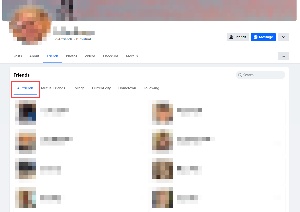
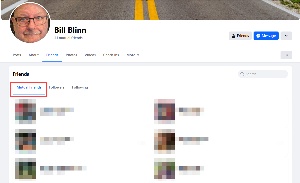 To illustrate the difference this makes, I visited a friend’s page and selected the link to see his friends. All of his 294 friends were displayed, not just the 49 friends we have in common.
To illustrate the difference this makes, I visited a friend’s page and selected the link to see his friends. All of his 294 friends were displayed, not just the 49 friends we have in common.
Then I logged in as Chloe Cat and, from her account, looked at the list of friends on my account. Only our 41 mutual friends were shown.
Changing this one setting won’t eliminate the danger of having your Facebook account cloned, but it will make your account unpalatable to crooks and substantially reduce the risk.